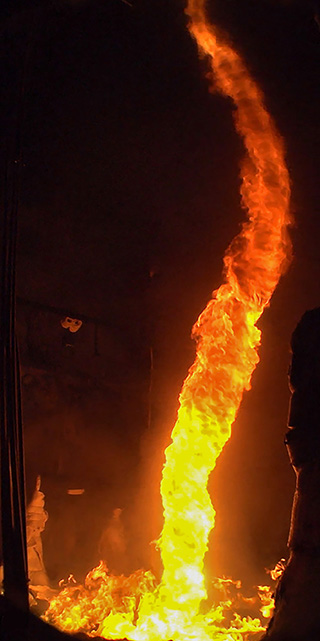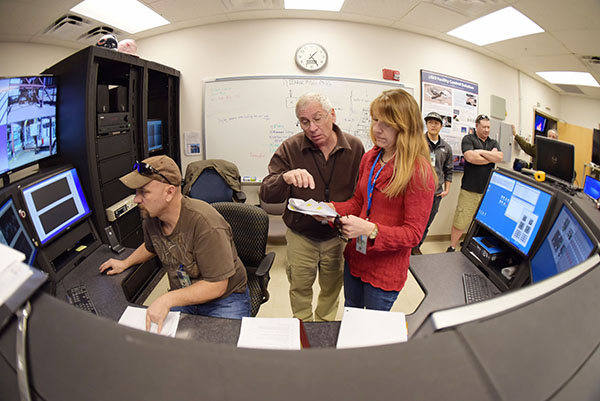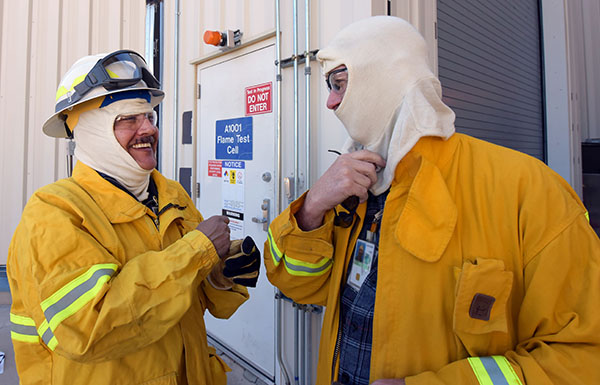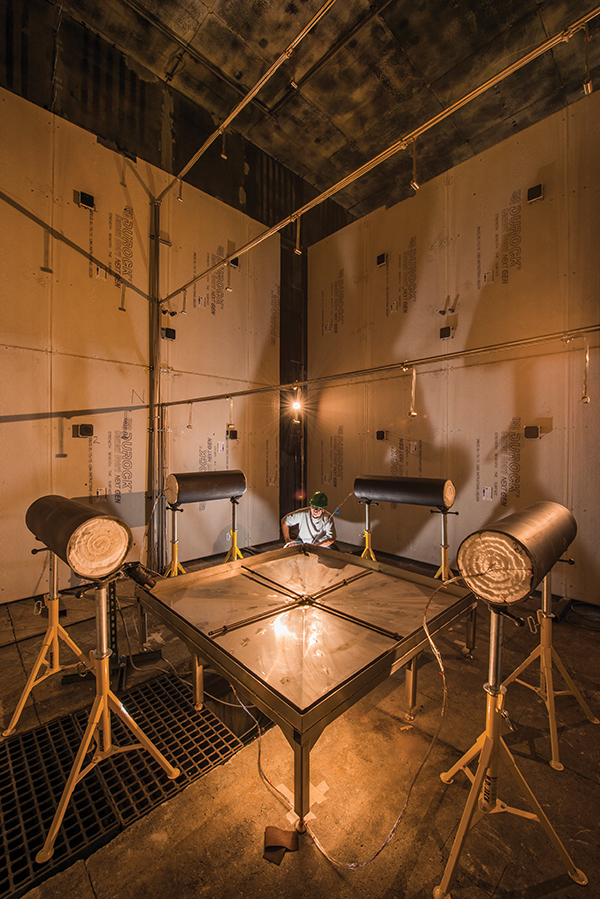Sandia flame cell tests, tames Godzilla-style fire

Fire whirls from a 3-meter diameter JP-8 test conducted in the FLAME facility. See video footage here.
The flame starts out like Bambi, looking slender and vulnerable in the array of video screens above the computer bank in the FLAME facility of Sandia’s Thermal Test Complex in Tech Area 3.
Within seconds, cameras record what appears to be a forest fire of rushing flames in a 16-foot-high test enclosure. Then flames burst out the cell’s top like a creature in a monster movie, towering almost to the roof of the 50-foot-tall building that houses the cell. One video screen looks like a black-and-white movie of a large building in flames. A full-color screen shows rich, yellow-red packets of flame whirling upward like escaping souls, while outside video cams show black smoke emerging from large stacks.
Then a safety switch, sensing a possible electrical overload, turns off a 750-horsepower fan engaged in sucking in outside air to equalize the pressure of air leaving up the stack. Operators monitoring the feedback information immediately cut the supply of fuel. The inferno becomes a river of fire, then a stream of fire, then a rivulet, and then it’s gone.
Validating fire-physics models
But the data collected about its fierce brief life remains.
Data from this and other experiments at the $40 million complex can be used to validate fire-physics models and qualify nuclear weapons hardware subjected to extreme conditions, says test director Anay Luketa (1532), who also performs analysis and simulations at the complex.

FIRE WATCH — Shane Adee, Tom Blanchat, and Anay Luketa (all 1532) review test procedures in the Thermal Test Complex control room. (Photo by Randy Montoya)

TEST-READY — Vince Valdez and Randy Foster (both 1533) about to enter FLAME for test preparation. (Photo by Randy Montoya)
“The objective of these FY16 experiments is to create an extreme abnormal thermal environment representative of what a weapon potentially could be exposed to,” she says. “The current test series controls boundary conditions and offers repeatable experiments, something difficult to achieve in outdoor flame tests where even a light wind can significantly tilt a fire plume.”
The FLAME team measures temperatures, heat flux, flame velocity, and height and burn rate of these whirling fire plumes. The whirl is created in an open-top, square enclosure surrounding a pool of fuel. The enclosing walls do not meet at the corners; rather there are gaps positioned to cause a rotational pattern of inflowing, entrained air induced by the fire. This causes the flame to spin and rise in a vortex from a pond of burning jet fuel contained in a 3-meter-diameter pan.
Members of the fire team wear burn suits where appropriate and follow 20 pages of instructions to ensure safe handling of materials and proper procedures during ignition and close-down. They methodically turn on pumps, enable valves, bleed fuel to purge unwanted air from the system, thereby minimizing false readings, and lock a succession of safety doors before powering up the ignitor.
A simple hammer tap
Basement cameras check for dripping fuel. A simple hammer tap creates a sound-signal that allows researchers to synchronize data collected from video cameras placed throughout the structure. A National Environmental Policy Act (NEPA) process adds ammonia within the external smoke stack to precipitate soot onto a large plate; simple banging with large pneumatic actuators drops the soot into a collection container. In an additional safety measure, the roof of the building can lift if necessary to reduce excess pressures by allowing fire-heated gasses to escape.
The interest in tracking fire whirls rather than ordinary burns is because whirls potentially generate much higher heat fluxes than non-rotational pool fires. “Whirls witnessed in forest fires and in urban areas have demonstrated disastrous impacts due to the generation of extremely high velocities coupled with high heat release rates,” says Anay.

Tom Blanchat prepares for a fuel pan and calorimeter test in the Cross Flow Fire Test Facility, or XTF. (Photo by Randy Montoya)